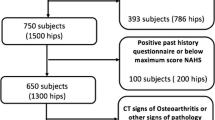Abstract
Objective
Cam hips are commonly quantified using the two-dimensional α angle. The accuracy of this measurement may be affected by patient position and the technician’s experience. In this paper, we describe a method of measurement that provides a quantitative definition of cam hips based upon three-dimensional computed tomography (CT) images.
Materials and methods
CT scans of 47 (24 cam, 23 normal) femurs were segmented. A sphere was fitted to the articulating surface of the femoral head, the radius (r) recorded, and the femoral neck axis obtained. The cross sectional area at four locations spanning the head neck junction (r/4, r/2, 3r/4 and r), perpendicular to the neck axis, was measured. The ratios (Neck/Head) between the areas at each cut relative to the surface area at the head centre were calculated and aggregated.
Results
Normal and cam hips were significantly different: the sum of the head-neck ratios (HNRs) of the cam hips were always smaller than normal hips (p < 0.01). A cut off point of 2.55 with no overlap was found between the two groups, with HNRs larger than this being cam hips, and smaller being normal ones.
Conclusion
Owing to its sensitivity and repeatability, the method could be used to confirm or refute the clinical diagnosis of a cam hip. Furthermore it can be used as a tool to measure the outcome of cam surgery.



Similar content being viewed by others
References
Meyer DC, Beck M, Ellis T, Ganz R, Leunig M. Comparison of six radiographic projections to assess femoral head/neck asphericity. Clin Orthop Relat Res. 2006;445:181–5.
Laude F, Boyer T, Nogier A. Anterior femoroacetabular impingement. Joint Bone Spine. 2007;74(2):127–32.
Notzli HP, Wyss TF, Stoecklin CH, Schmid MR, Treiber K, Hodler J. The contour of the femoral head-neck junction as a predictor for the risk of anterior impingement. J Bone Joint Surg Br. 2002;84(4):556–60.
Bedi A, Dolan M, Hetsroni I, Magennis E, Lipman J, Buly R, et al. Surgical treatment of femoroacetabular impingement improves hip kinematics: a computer-assisted model. Am J Sports Med. 2011;39(Suppl):43–9.
Siebenrock KA, Wahab KH, Werlen S, Kalhor M, Leunig M, Ganz R. Abnormal extension of the femoral head epiphysis as a cause of cam impingement. Clin Orthop Relat Res. 2004;418:54–60.
Barton C, Salineros MJ, Rakhra KS, Beaule PE. Validity of the alpha angle measurement on plain radiographs in the evaluation of cam-type femoroacetabular impingement. Clin Orthop Relat Res. 2011;469(2):464–9.
Gosvig KK, Jacobsen S, Palm H, Sonne-Holm S, Magnusson E. A new radiological index for assessing asphericity of the femoral head in cam impingement. J Bone Joint Surg Br. 2007;89(10):1309–16.
Beaule PE, Zaragoza E, Motamedi K, Copelan N, Dorey FJ. Three-dimensional computed tomography of the hip in the assessment of femoroacetabular impingement. J Orthop Res. 2005;23(6):1286–92.
Tsitskaris K, Sharif K, Meacock LM, Bansal M, Ayis S, Li PL, et al. The prevalence of cam-type femoroacetabular morphology in young adults and its effect on functional hip scores. Hip Int. 2012;22(1):68–74.
Husmann O, Rubin PJ, Leyvraz PF, de Roguin B, Argenson JN. Three-dimensional morphology of the proximal femur. J Arthroplast. 1997;12(4):444–50.
Steppacher SD, Tannast M, Werlen S, Siebenrock KA. Femoral morphology differs between deficient and excessive acetabular coverage. Clin Orthop Relat Res. 2008;466(4):782–90.
Pfirrmann CW, Mengiardi B, Dora C, Kalberer F, Zanetti M, Hodler J. Cam and pincer femoroacetabular impingement: characteristic MR arthrographic findings in 50 patients. Radiology. 2006;240(3):778–85.
Dudda M, Albers C, Mamisch TC, Werlen S, Beck M. Do normal radiographs exclude asphericity of the femoral head-neck junction? Clin Orthop Relat Res. 2009;467(3):651–9.
Cobb J, Logishetty K, Davda K, Iranpour F. Cams and pincer impingement are distinct, not mixed: the acetabular pathomorphology of femoroacetabular impingement. Clin Orthop Relat Res. 2010;468(8):2143–51.
Cobb JP, Davda K, Ahmad A, Harris SJ, Masjedi M, Hart AJ. Why large-head metal-on-metal hip replacements are painful: the anatomical basis of psoas impingement on the femoral head-neck junction. J Bone Joint Surg Br. 2011;93(7):881–5.
Acknowledgement
We would like to thank the Wellcome trust and EPSRC for funding part of the project.
Author information
Authors and Affiliations
Corresponding author
Rights and permissions
About this article
Cite this article
Masjedi, M., Marquardt, C.S., Drummond, I.M.H. et al. Cam type femoro-acetabular impingement: quantifying the diagnosis using three dimensional head-neck ratios. Skeletal Radiol 42, 329–333 (2013). https://doi.org/10.1007/s00256-012-1459-5
Received:
Revised:
Accepted:
Published:
Issue Date:
DOI: https://doi.org/10.1007/s00256-012-1459-5




